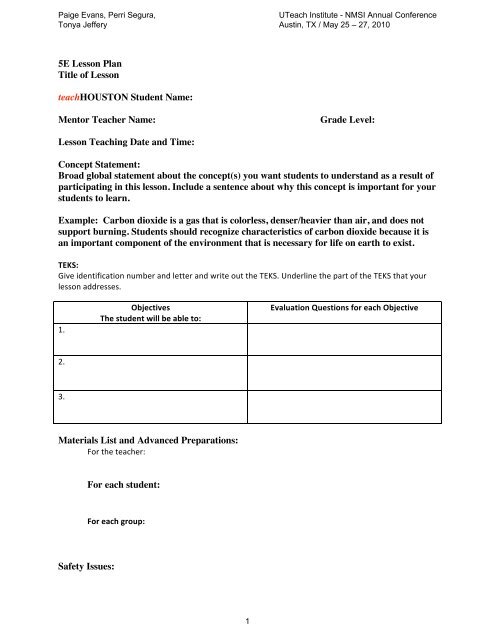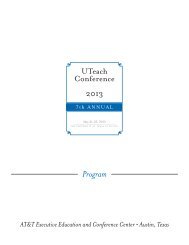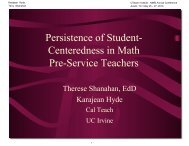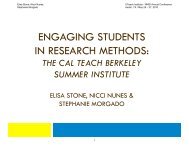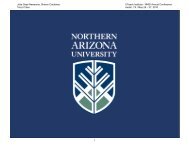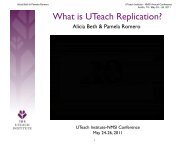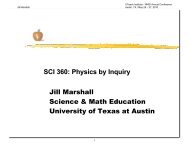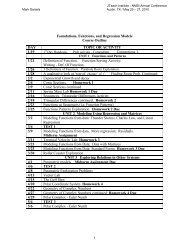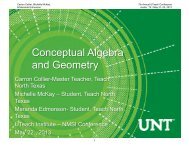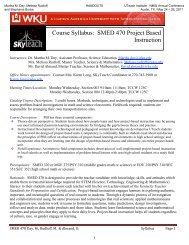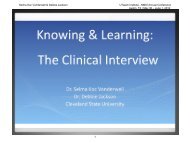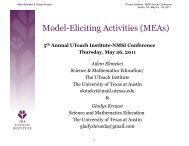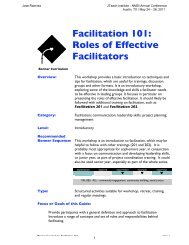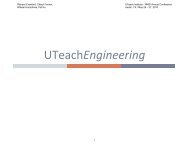5E Lesson Plan Template S2 Science - The UTeach Institute
5E Lesson Plan Template S2 Science - The UTeach Institute
5E Lesson Plan Template S2 Science - The UTeach Institute
You also want an ePaper? Increase the reach of your titles
YUMPU automatically turns print PDFs into web optimized ePapers that Google loves.
Paige Evans, Perri Segura,<br />
Tonya Jeffery<br />
<strong>UTeach</strong> <strong>Institute</strong> - NMSI Annual Conference<br />
Austin, TX / May 25 – 27, 2010<br />
<strong>5E</strong> <strong>Lesson</strong> <strong>Plan</strong><br />
Title of <strong>Lesson</strong><br />
teachHOUSTON Student Name:<br />
Mentor Teacher Name:<br />
Grade Level:<br />
<strong>Lesson</strong> Teaching Date and Time:<br />
Concept Statement:<br />
Broad global statement about the concept(s) you want students to understand as a result of<br />
participating in this lesson. Include a sentence about why this concept is important for your<br />
students to learn.<br />
Example: Carbon dioxide is a gas that is colorless, denser/heavier than air, and does not<br />
support burning. Students should recognize characteristics of carbon dioxide because it is<br />
an important component of the environment that is necessary for life on earth to exist.<br />
<br />
TEKS: <br />
Give identification number and letter and write out the TEKS. Underline the part of the TEKS that your <br />
lesson addresses. <br />
Objectives <br />
<strong>The</strong> student will be able to: <br />
1. <br />
Evaluation Questions for each Objective <br />
2. <br />
<br />
<br />
3. <br />
<br />
<br />
<br />
<br />
Materials List and Advanced Preparations:<br />
For the teacher: <br />
For each student:<br />
<br />
<br />
For each group: <br />
<br />
<br />
Safety Issues:<br />
1
Paige Evans, Perri Segura,<br />
Tonya Jeffery<br />
<strong>UTeach</strong> <strong>Institute</strong> - NMSI Annual Conference<br />
Austin, TX / May 25 – 27, 2010<br />
Classroom Management:<br />
Five-E Organization<br />
ENGAGEMENT<br />
What the Teacher<br />
Will Do and<br />
Student<br />
Misconceptions<br />
Include an<br />
interesting and<br />
understandable<br />
attention grabber<br />
that relates directly<br />
to the concept being<br />
taught.<br />
Time: Minutes<br />
Probing/Eliciting Questions and<br />
Students Responses<br />
Check for prior knowledge and<br />
students’ experiences.<br />
List critical questions that will<br />
establish prior knowledge and<br />
create a need to know.<br />
List critical questions that will<br />
address common student<br />
misconceptions.<br />
What the Students Will Do<br />
Describe what the students will<br />
do.<br />
Include the hoped-for correct<br />
responses that students might<br />
give. [Give correct responses in<br />
brackets.]<br />
Transition Statement<br />
What will you say to transition students from the Engagement Section to the Exploration?<br />
Important questions to answer:<br />
(a) What is the purpose of the next activity?<br />
(b) Why do students need to know the information?<br />
(c) How does the next activity connect to the engagement?<br />
EXPLORATION<br />
Time: Minutes<br />
What the Teacher Will Do<br />
and Student Misconceptions<br />
Describe what you will do and<br />
say to introduce and guide the<br />
student exploration.<br />
Explain step-by-step what the<br />
students will do to explore the<br />
concept. Include information<br />
on how the class will be<br />
organized. Specific directions<br />
for the exploration may be<br />
included separately as a<br />
Probing/Eliciting<br />
Questions and Student<br />
Responses<br />
Use questions to guide<br />
student explorations,<br />
evaluate student<br />
understanding, and<br />
facilitate student<br />
interaction and group<br />
collaboration.<br />
List questions you will<br />
ask to check for<br />
students’ understanding<br />
What the Students Will Do<br />
List step by step what the<br />
students will do to explore the<br />
concept.<br />
2
Paige Evans, Perri Segura,<br />
Tonya Jeffery<br />
<strong>UTeach</strong> <strong>Institute</strong> - NMSI Annual Conference<br />
Austin, TX / May 25 – 27, 2010<br />
handout for students.<br />
Check to make sure students<br />
understand the procedures<br />
before students begin the<br />
activity.<br />
of the activity before<br />
they begin to work on<br />
their own.<br />
Also include probing<br />
questions to guide<br />
student explorations and<br />
evaluate student<br />
understanding while<br />
they are working.<br />
Include the hoped-for<br />
correct responses that<br />
students might give.<br />
[Give correct responses<br />
in brackets.]<br />
List any potential<br />
misconceptions students<br />
might have and the<br />
possible incorrect<br />
responses that students<br />
might give due to<br />
misconceptions.<br />
Transition Statement<br />
What will you say to transition students from the Exploration Section to the Explanation?<br />
Important questions to answer:<br />
(a) What is the purpose of the next activity?<br />
(b) Why do students need to know the information?<br />
(c) How does the next activity connect to the engagement?<br />
EXPLANATION<br />
Time: Minutes<br />
What the Teacher Will Do<br />
and Student Misconceptions<br />
Have students present and<br />
explain the results of their<br />
investigation.<br />
Add additional content,<br />
including definitions,<br />
explanations, and new<br />
vocabulary in the context of<br />
concepts explored.<br />
Summarize and clarify<br />
Probing/Eliciting<br />
Questions and Student<br />
Responses<br />
List questions that will<br />
deepen and clarify<br />
students’ conceptual<br />
understanding and<br />
skills.<br />
List critical questions<br />
that will address<br />
common student<br />
misconceptions.<br />
What the Students Will Do<br />
Describe what the students will<br />
do.<br />
3
Paige Evans, Perri Segura,<br />
Tonya Jeffery<br />
<strong>UTeach</strong> <strong>Institute</strong> - NMSI Annual Conference<br />
Austin, TX / May 25 – 27, 2010<br />
students’ understanding to<br />
make sure that students will<br />
be able to demonstrate the<br />
performance objectives.<br />
Relate the activity and results<br />
to the science and/or<br />
mathematics concept(s).<br />
Include the hoped-for<br />
correct responses that<br />
students might give.<br />
[Give correct responses<br />
in brackets.]<br />
Transition Statement<br />
What will you say to transition students from the Explanation Section to the Elaboration?<br />
Important questions to answer:<br />
(a) What is the purpose of the next activity?<br />
(b) Why do students need to know the information?<br />
(c) How does the next activity connect to the engagement?<br />
ELABORATION<br />
Time: Minutes<br />
What the Teacher Will Do<br />
and Student Misconceptions<br />
Provide students with the<br />
opportunity to transfer and<br />
extend (apply) the concepts<br />
and skills they have just<br />
learned to new situations.<br />
Probing/Eliciting<br />
Questions and Student<br />
Responses<br />
Connect and apply the<br />
lesson to students’<br />
interests outside the<br />
classroom (not intended<br />
as a homework<br />
assignment).<br />
What the Students Will Do<br />
Describe student actions.<br />
Include the hoped-for<br />
correct responses that<br />
students might give.<br />
[Give correct responses<br />
in brackets.]<br />
List any potential<br />
misconceptions students<br />
might have and the<br />
possible incorrect<br />
responses that students<br />
might give due to<br />
misconceptions.<br />
EVALUATION<br />
What the Teacher Will Do<br />
Time: Minutes<br />
Probing/Eliciting<br />
Questions<br />
What the Students Will Do<br />
4
Paige Evans, Perri Segura,<br />
Tonya Jeffery<br />
<strong>UTeach</strong> <strong>Institute</strong> - NMSI Annual Conference<br />
Austin, TX / May 25 – 27, 2010<br />
Bring the lesson to closure.<br />
Design an evaluation tool to<br />
assess the students’ mastery<br />
of the performance objectives.<br />
During each lesson,<br />
administer and collect a preand<br />
post-test in order to<br />
analyze students’ learning.<br />
You may describe and use<br />
student responses when<br />
assessing prior knowledge<br />
during ENGAGE as your preassessment<br />
instrument.<br />
Use probing questions to<br />
check for mastery of<br />
concepts and skills<br />
presented in the lesson.<br />
Include the hoped-for<br />
correct responses that<br />
students might give.<br />
[Give correct responses<br />
in brackets.]<br />
List any potential<br />
misconceptions students<br />
might have and the<br />
possible incorrect<br />
responses that students<br />
might give due to<br />
misconceptions.<br />
5
Paige Evans, Perri Segura,<br />
Tonya Jeffery<br />
<strong>UTeach</strong> <strong>Institute</strong> - NMSI Annual Conference<br />
Austin, TX / May 25 – 27, 2010<br />
Evaluation<br />
1. <br />
<br />
<br />
<br />
<br />
<br />
<br />
<br />
2. <br />
<br />
<br />
<br />
<br />
<br />
<br />
<br />
<br />
<br />
<br />
<br />
<br />
3.<br />
6
Paige Evans, Perri Segura,<br />
Tonya Jeffery<br />
<strong>UTeach</strong> <strong>Institute</strong> - NMSI Annual Conference<br />
Austin, TX / May 25 – 27, 2010<br />
Overhead Transparency<br />
7
Paige Evans, Perri Segura,<br />
Tonya Jeffery<br />
<strong>UTeach</strong> <strong>Institute</strong> - NMSI Annual Conference<br />
Austin, TX / May 25 – 27, 2010<br />
Activity Sheet<br />
<br />
8
Paige Evans, Perri Segura,<br />
Tonya Jeffery<br />
<strong>UTeach</strong> <strong>Institute</strong> - NMSI Annual Conference<br />
Austin, TX / May 25 – 27, 2010<br />
<strong>Lesson</strong> <strong>Plan</strong>ning Guide <br />
<br />
<strong>Science</strong> <br />
Topic <br />
<br />
<br />
TEKS # Student Expectation Sample TAKS Problem <br />
<br />
<br />
<br />
Review at least 3 different LP resources before completing the next page. Delete the rows of resources <br />
that you did not review. <br />
Resource Brief Description (pg #) Evaluation: Dislike (1) – Like (5) <br />
with Rationale/Comments <br />
Activities from MT <br />
<br />
Region IV Accelerated <br />
Curriculum ‐ Gateway <br />
tH <strong>Lesson</strong> Bank <br />
<br />
Activities from tH <br />
Student Worker <br />
Textbook <br />
Web: <strong>Science</strong> TEKS <br />
Toolkit <br />
Web: <strong>Science</strong> <br />
Benchmark <br />
Assessments <br />
Web: Middle School <br />
<strong>Science</strong> <br />
Web: PBS <br />
Web: Texas <br />
<br />
Instruments <br />
Other <br />
<br />
<br />
<br />
<br />
9
Paige Evans, Perri Segura,<br />
Tonya Jeffery<br />
<strong>UTeach</strong> <strong>Institute</strong> - NMSI Annual Conference<br />
Austin, TX / May 25 – 27, 2010<br />
<strong>Lesson</strong> <strong>Plan</strong>ning Guide <br />
<br />
<br />
<br />
Objectives <br />
Write objectives in SWBAT form <br />
Evaluation Questions <br />
Each question should match the written objective <br />
1 <br />
<br />
2 <br />
<br />
3 <br />
<br />
<br />
Possible Activities (attach copies if necessary) <br />
Engage <br />
<br />
Explore <br />
<br />
Explain <br />
<br />
Elaborate <br />
<br />
Evaluate <br />
<br />
<br />
10
Paige Evans, Perri Segura,<br />
Tonya Jeffery<br />
<strong>Science</strong> Step 2 <strong>Lesson</strong> <strong>Plan</strong> Rubric<br />
<strong>UTeach</strong> <strong>Institute</strong> - NMSI Annual Conference<br />
Austin, TX / May 25 – 27, 2010<br />
Teach 1 Rubric<br />
LESSON PLAN ELEMENTS<br />
Concept(s)<br />
TEKS<br />
Objectives for <strong>Lesson</strong><br />
Equipment list and<br />
All student materials/Visual<br />
Aids<br />
Safety Requirements<br />
Classroom Management<br />
Engagement<br />
Exploration<br />
1 – Present or Approaching<br />
requirements<br />
Broad global statement about the<br />
concept(s) you want your students to<br />
learn which includes why this concept<br />
is important for your students to learn.<br />
Includes process TEKS and content<br />
TEKS which directly apply to lesson<br />
objectives<br />
States an appropriate number of<br />
objectives.<br />
Contains a detailed description of all<br />
equipment that will be used by<br />
students and instructor.<br />
Includes copies of all materials (hand<br />
outs, assessments, instructions) that<br />
will be distributed to students.<br />
Instructs students in safe experimental<br />
procedures.<br />
Incorporates all STEP 2 Goals/Skills<br />
Includes an interesting and<br />
understandable attention grabber that<br />
directly relates to the concept being<br />
taught.<br />
Lists step by step what the students<br />
will do to explore the concept. Probing<br />
questions are included.<br />
2 – Meets requirements Comments Points<br />
States an appropriate number of<br />
specific, measureable objectives with<br />
clear power verbs.<br />
Includes an interesting and<br />
understandable attention grabber that<br />
directly relates to the concept being<br />
taught. Checks for prior knowledge.<br />
Includes possible answers to all<br />
questions. Correct responses are given<br />
in brackets.<br />
Lists step by step what the students will<br />
do to explore the concept. Probing<br />
questions are included. Includes<br />
possible answers to all questions.<br />
Correct responses are given in<br />
brackets.<br />
11
Paige Evans, Perri Segura,<br />
Tonya Jeffery<br />
Teach 1 Rubric<br />
LESSON PLAN ELEMENTS<br />
Explanation<br />
Elaboration<br />
Evaluation/Assessments<br />
1 – Present or Approaching<br />
requirements<br />
Allows students to present and explain<br />
the results of their activity. Includes<br />
questions that will deepen and clarify<br />
studentsʼ conceptual understanding.<br />
Guides the students in applying the<br />
concept(s) to new situations. Includes<br />
questions to help students connect and<br />
apply the lesson to their interests.<br />
Includes copy of assessment. Most<br />
assessment questions match<br />
performance objectives.<br />
<strong>UTeach</strong> <strong>Institute</strong> - NMSI Annual Conference<br />
Austin, TX / May 25 – 27, 2010<br />
2 – Meets requirements Comments Points<br />
Allows students to present and explain<br />
the results of their activity. Includes<br />
questions that will deepen and clarify<br />
studentsʼ conceptual understanding.<br />
Includes possible answers to all<br />
questions. Correct responses are given<br />
in brackets.<br />
Guide the students in applying the<br />
concept(s) to new situations. Includes<br />
questions to help students connect and<br />
apply the lesson to their interests.<br />
Includes possible answers to all<br />
questions. Correct responses are given<br />
in brackets.<br />
Includes copy of all assessments (pre<br />
and post). All assessment questions<br />
are aligned with performance<br />
objectives.<br />
Use of Questioning<br />
Probing questions presented to help<br />
student get at concept, but more<br />
questions are needed<br />
A sufficient number of in-depth<br />
questions presented to help students<br />
understand concepts.<br />
Transition Statements<br />
All transition statements explaining the<br />
goal of the next activity are included<br />
and connect one E section to the next<br />
E section. Written in a script form of<br />
what will be said to the students.<br />
TOTAL<br />
12
Paige Evans, Perri Segura,<br />
Tonya Jeffery<br />
<strong>UTeach</strong> <strong>Institute</strong> - NMSI Annual Conference<br />
Austin, TX / May 25 – 27, 2010<br />
FEEDBACK on Individual <strong>Lesson</strong>s<br />
STEP 1<br />
Please fill this out and hand to student before he/she leaves your class.<br />
Mentor Teacher Name:<br />
Student Name:<br />
__________________________<br />
Date: _____________________<br />
Time: __________ to __________<br />
(Circle One)<br />
<strong>Lesson</strong> 1 <strong>Lesson</strong> 2 <strong>Lesson</strong> 3<br />
Observed: Evident Not<br />
Evident<br />
Arrived on time (at least 30 minutes<br />
early)<br />
Starts and ends on time<br />
Comments<br />
Dressed appropriately<br />
Was well prepared<br />
Spoke clearly, with appropriate volume<br />
Used attention getting strategies<br />
Did not talk over students<br />
Addressed students by name<br />
Gave clear instructions for activity<br />
Activities strengthened students’<br />
understanding of lesson objectives<br />
Involved all students in the activity<br />
Managed the activity materials well<br />
Used good questions to get at student<br />
understanding<br />
Please fill out the back.<br />
13
Paige Evans, Perri Segura,<br />
Tonya Jeffery<br />
List two strengths:<br />
<strong>UTeach</strong> <strong>Institute</strong> - NMSI Annual Conference<br />
Austin, TX / May 25 – 27, 2010<br />
List two areas for improvement:<br />
14
Paige Evans, Perri Segura,<br />
Tonya Jeffery<br />
<strong>UTeach</strong> <strong>Institute</strong> - NMSI Annual Conference<br />
Austin, TX / May 25 – 27, 2010<br />
FEEDBACK on Individual <strong>Lesson</strong>s<br />
STEP 2<br />
Please fill this out and hand to student before he/she leaves your class.<br />
Mentor Teacher Name:<br />
Student Name:<br />
__________________________<br />
Date: _____________________<br />
Time: __________ to __________<br />
(Circle One)<br />
<strong>Lesson</strong> 1 <strong>Lesson</strong> 2 <strong>Lesson</strong> 3<br />
Observed: Evident Not<br />
Evident<br />
Arrived on time (at least 30 minutes<br />
early)<br />
Starts and ends on time<br />
Comments<br />
Dressed appropriately<br />
Was well prepared<br />
Greeted students at the door<br />
Spoke clearly, with appropriate volume<br />
Used attention getting strategies<br />
Did not talk over students<br />
Addressed students by name<br />
Gave clear instructions for activity<br />
Activities strengthened students’<br />
understanding of lesson objectives<br />
Involved all students in the activity<br />
Managed the activity materials well<br />
Addressed all the lesson objectives<br />
Asked good questions to get at<br />
student understanding<br />
Please fill out the back.<br />
15
Paige Evans, Perri Segura,<br />
Tonya Jeffery<br />
List two strengths:<br />
<strong>UTeach</strong> <strong>Institute</strong> - NMSI Annual Conference<br />
Austin, TX / May 25 – 27, 2010<br />
List two areas for improvement:<br />
16
Paige Evans, Perri Segura,<br />
Tonya Jeffery<br />
<strong>UTeach</strong> <strong>Institute</strong> - NMSI Annual Conference<br />
Austin, TX / May 25 – 27, 2010<br />
<br />
<br />
Classroom Management <br />
Courses Goals/Skills Evidence/Implementation <br />
STEP 1 • Uses attention‐getting strategies <br />
• Utilizes an effective “teacher voice” <br />
• Uses of a method of knowing students <br />
names <br />
• Assigns student tasks for cooperative <br />
groups <br />
• Uses effective procedures and routines <br />
o Starts and ends on time <br />
• Utilizes power point to enhance <br />
implementation <br />
STEP 2 • Uses attention‐getting strategies <br />
• Utilizes an effective “teacher voice” <br />
• Uses of a method of knowing students <br />
names <br />
• Assigns student tasks for cooperative <br />
groups <br />
• Uses effective procedures and routines <br />
Classroom <br />
Interactions <br />
o Starts and ends on time <br />
o Assigns time limits to each activity <br />
• Develops power point to enhance <br />
implementation <br />
• Greet students at the door <br />
• Uses effective transitions for grouping <br />
• Uses attention‐getting strategies <br />
• Utilizes an effective “teacher voice” <br />
• Uses of a method of knowing students <br />
names <br />
• Develops student tasks for cooperative <br />
groups <br />
• Uses effective procedures and routines <br />
o Starts and ends on time <br />
o Assigns time limits to each activity <br />
• Develops power point to enhance <br />
implementation <br />
• Greet students at the door <br />
• Uses effective transitions for grouping <br />
• Discipline management strategies <br />
o<br />
o<br />
o<br />
Redirects/stops inappropriate <br />
behavior <br />
(example: sleeping, talking, getting <br />
out of seat, etc.) <br />
Proximity <br />
Gives clear instructions <br />
• Documented on mentor feedback form <br />
• Documented on master teacher <br />
observation form <br />
• <strong>Plan</strong>s written out on <strong>Lesson</strong> <strong>Plan</strong>ning <br />
Guide <br />
• Role playing during practice teach <br />
• Written and verbal reflections from <br />
students’ teaching experiences <br />
• Documented on mentor feedback form <br />
• Documented on master teacher <br />
observation form <br />
• <strong>Plan</strong>s written out on <strong>Lesson</strong> <strong>Plan</strong>ning <br />
Guide <br />
• Role playing during practice teach <br />
• Written and verbal reflections from <br />
students’ teaching experiences <br />
• Documented on mentor feedback form <br />
• Documented on master teacher <br />
observation form <br />
• Role playing during practice teach <br />
• Article, reflection, class work <br />
• Written and verbal reflections from <br />
students’ teaching experiences <br />
17


